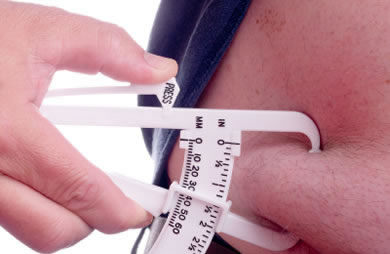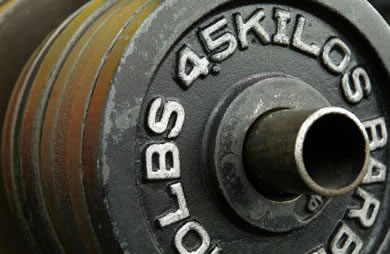By COMPFC,
SparkPeople Blogger
10/31/2011
One of the most concerning physical changes that occurs in postmenopausal women is an accelerated loss in bone mineral density within the first several years after menopause. The rate of postmenopausal bone loss can vary for each woman, and factors such as her bone mineral density prior to menopause, diet, exercise level and genetics all influence her rate of bone loss.
All types of exercise are great for your health, but to build strong bones, weight-bearing exercises like running, stair climbing, walking and strength training are increasingly shown to help prevent bone loss in postmenopausal women.
Recent studies have found that combining weight bearing exercises like walking or running or even jump roping with higher-intensity, lower-repetition strength training three times a week was more beneficial for bone mineral density (bone mineral density) than just doing the cardio exercise alone.
One of the key findings from bone mineral density research is that only the areas of the body that are loaded by the force of muscle movement are stimulated to rebuild and increase in bone mineral density. For example, if you're a postmenopausal runner who doesn't do any upper body strength training, you may have bone loss in the bones of your upper body. Just like the saying about tooth health and flossing, “only floss the teeth you want to save” you need to think about your whole skeletal system when developing an exercise program, and include exercises that'll target your entire body.
What helps maintain and even increase bone mineral density in postmenopausal women?
Bone strength, just like muscle strength, is dependent upon the loads placed on them; both respond to an increase in mechanical loading (such as walking or weight training) with an increase in strength. It's the same overload principle that causes your muscles to gain strength with weight lifting and your heart to become stronger and more efficient with cardiovascular exercise training. When the overload principle is applied to bone, it corresponds with greater bone mineral density and a reduced risk of fracture.
In order to help you develop a bone mineral density targeted exercise routine I've listed an overview of the five principles of training discussed in an excellent article by osteoporosis researcher Barbara Drinkwater, PhD. These principles explain the factors that impact how exercise affects bone mineral density. Each principle is an important component in understanding the how and why of bone strength building, and using this information will help you create a program that will positively impact your bone mineral density.
I've provided an explanation of each principle and suggestions for how you can incorporate the principle into your training. Following this section are some general guidelines I've compiled to help you with your program development.
1. Specificity: The bones that are loaded are the ones that will respond to the exercise.
- Choose several types of weight-bearing exercises that you can vary throughout the week.
- Tennis and other racquet exercises work your upper and lower body.
- Running, walking and stair climbing target your lower body.
- Weight training can be used to target all muscles groups with specific exercises.
2. Overload: You need apply a load greater than what your daily activity is to stimulate increases in bone mineral density.
- Most studies found that 70-90% of maximal exercise effort was the target zone for significant increases in bone mineral density, but most people don't have access testing to determine their maximal capacity, so working at an intensity where they're feeling challenged is the goal.
- Training heart rate can be used to establish exercise intensity. If you'd like to determine what your training heart rate should be to work at 70-90% of maximal check out this link, but keep in mind that for most people 90% of maximal is not suggested and you shouldn't attempt the higher intensity level without consulting with your healthcare provider. Start with working out at 70% or lower, and increase your intensity as your fitness level improves.
3. Reversibility: Gains made through exercise training will normally be lost in adults if the exercise program is discontinued. - The saying “use it or lose it” applies, and you need to maintain your fitness routine throughout your life to continue to get the benefits. Studies have shown that exercise induced gains in bone mineral density are lost within a year or less after discontinuing a bone strengthening exercise program.
4. Initial values: Those with below average initial bone mineral density values will usually show greater increases in bone mineral density with training than those with normal or higher than average bone mineral density values. - If you start a bone strengthening exercise program with a low bone mineral density baseline you will show greater increases in bone mineral density compared with those who do the same routine but started with a greater bone mineral density at baseline.
- Another way to look at this principle is by understanding that there is a range of bone mineral density levels established that correspond to low, normal and high bone mineral density in postmenopausal women. If you're on the lower end of the range you have a greater level of improvement that can be gained than a woman who is on the high end of bone mineral density limits.
5. Diminished Returns: There are greater gains in bone mineral density early in an exercise training program, with slower increases seen as the program continues. Bone mineral density improvements will be maintained only when the exercise program continue to increase the workout intensity.
- This principle is somewhat similar to the previous one, as the closer you get to your genetic ceiling for bone mineral density the slower your gains will be. Just like with muscular strength training, you need to continue increasing the workload to reach higher strength gains. As you near your muscles limits, it will take more loading to bring about increases in strength, and the rate of hypertrophy (growth) will slow.
An example of an effective bone-strengthening exercise routine would include 30 to 60 minutes of moderate- to high-intensity weight-bearing cardiovascular exercise at least three days a week. Vary the type of exercise to include different parts of the body during the week. Examples of weight-bearing exercise:
- Walking
- Jogging/Running
- Step aerobics
- Stair climbing
- Jumping rope
- Dancing
- Racquet sports
- Tai Chi
- Yoga
Three sessions a week of strength training that consists of 1-2 sets of 8-10 repetitions for upper body, core and lower body is recommended. The weight or resistance should be challenging enough to reach fatigue by the last few repetitions. Research on bone strengthening activities showed better results were achieved when lower repetition/higher resistance weight training was used.
Types of weight training:
- Resistance band
- Free weights
- Machines
- Kettle bells
- Body weight supported such as push-ups
Although swimming is considered non-weight bearing exercise, some research suggests a positive effect on bone density may occur through loads created from high intensity resistance exercise (such as working against the drag of water as you move your arms and legs while exercising in water). That's good news for women who are deconditioned, arthritic or are unable to do weight bearing exercise, as swimming is a safe and comfortable way to be able to take part in an fitness routine.
If your balance is poor, avoid exercises that put you at risk for a fall. For some women, using walking poles help them with balance, and stair climbing can be a good way to safely exercise when a railing is used for balance. Just remember to start with an exercise that fits your level of fitness and ability, and don't continue any exercise that makes your feel extremely exhausted or causes pain.
Before starting any fitness program make sure to talk with your healthcare provider about what kind of exercise is right for you. Once you get the go-ahead to exercise start slowly and allow your body time to adjust to any new activities, especially if you already are diagnosed with osteoporosis.
For more information on how to prevent osteoporosis through exercise, diet and current treatments visit the National Osteoporosis Foundation.
For more bone-building exercise routines, try these from the SparkPeople video collection:
Do you regularly do weight-bearing exercises?
|
|















